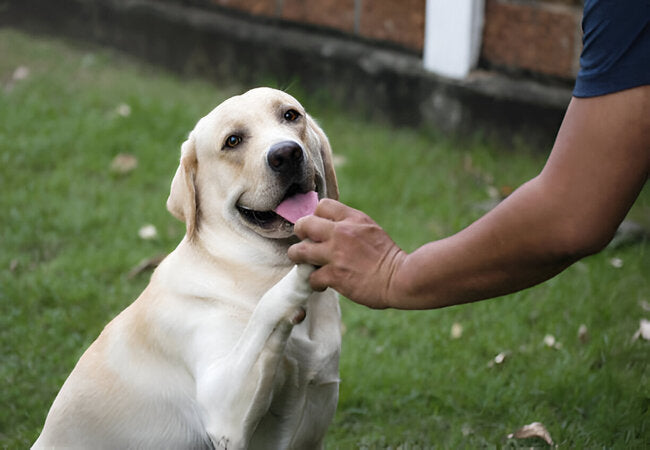How to Train a Deaf Dog in 2025 – Vet‑Approved, Visual & Vibration Techniques 🐶✨

In this article
How to Train a Deaf Dog in 2025 – Vet‑Approved, Visual & Vibration Techniques 🐶✨
By Dr. Duncan Houston BVSc
Training a deaf dog isn’t just possible—it can be a deeply rewarding journey that strengthens your bond and sharpens communication. In 2025, vets and trainers emphasize visual clarity and positive reinforcement, enabling deaf dogs to learn obedience, tricks, and routine cues. This comprehensive guide explores hand signals, eye-contact markers, vibration collars, mat training, and safety measures to help your deaf companion thrive. Let’s dive in! 🐾
1. 🧠 Why Visual & Tactile Methods Shine
- Deaf dogs miss auditory cues, so **hand signals** become primary communication tools.
- They can learn as quickly as hearing dogs when cues are clear, consistent, and reinforced effectively.
- Visual and vibration systems reduce confusion and boost bonding.
2. ✋ Building Clear Hand Signals
Hand signals replace verbal commands—make them distinct, consistent, and easy to see.
- Use simple, one-handed cues like ASL style or homemade signals.
- Choose a consistent signal for each behavior (e.g., thumb‑up for “sit”) and ensure everyone in your household uses the same gestures.
- Begin training with lure‑and‑reward: shape the behavior and add a signal before the action, then reward.
- Move to signal‑first, then encourage the behavior, reinforcing with flash/treat.
3. 👀 Teach “Watch Me” for Connection
“Watch me” encourages your dog to look at you—a key step before giving any command.
- Flash your hand sign when your dog makes eye contact and immediately reward.
- Practice frequently, fading treats gradually so eye contact becomes habitual.
- This visual check‑in improves focus before commands or recalls.
4. 🔔 Using a Vibration Collar for Distance
Vibration collars offer a silent tactile cue—perfect for recalls or alerts beyond visual range.
- Introduce vibration as a neutral signal: pair it with treats until it predicts a reward.
- Use for behavior like recall—vibrate, wait for look or movement, then reward.
- Avoid shame‑based use—only use short, positive pulses paired with rewards.
5. 🧘 Mat or "Settle" Training
Teaching a “mat” behavior gives your deaf dog a safe, calm space, essential in active environments or vet visits.
- Start with rewarding a paw on the mat, then build to a full-body “settle”.
- Add a visual signal (e.g., point or hand wave) once behavior is learned.
- Use in real-world scenarios to reduce stress and reinforce calm.
6. 📋 Putting It Together: Daily Training Routine
- Short, distraction-free sessions—2–5 minutes, 5 times a day.
- Warm up with “watch‑me” ➝ hand‑signal behavior guide ➝ reward.
- Proof behaviors in increasingly real conditions: room → garden → park.
- Use long line for recalls and vibration tests in low-to-moderate distraction.
- Gently fade treats, but keep flash or affection every time.
7. 🛑 Safety & Management Tips
- Never off-leash in unwalled open spaces until recall is rock-solid.
- Use long lines and harnesses during early outdoor practice.
- Always visually announce yourself before touching or approaching to avoid startling.
- Wear a “Deaf Dog” vest or add clear tags to inform others that your dog doesn't hear.
8. 💡 Troubleshooting Common Issues
| Problem | Cause | Vet‑Approved Solution |
|---|---|---|
| The dog ignores signal | Lack of eye contact or focus | Do more “watch‑me” practice; reward attention first. |
| Won’t settle on the mat | Mat unknown or unstimulating | Start tiny, reinforce early steps—step on the mat first. |
| Scared by vibration | Unfamiliar, sudden cue | Start in calm, pair with treats until positive. |
| Bolts off-leash | Low recall trust | Return to long-line training and high-value vs distractions. |
9. 🐶 Case Study: “Ghost” the Deaf Great Dane
A family's Great Dane born deaf learned hand signals and vibration cues under a consistent routine. Visual signals like finger wags ("no") replaced verbal corrections. Though he couldn’t hear, Ghost thrived—learning sit, come, settle, and more—showing deaf dogs *can* learn deeply and happily.
10. 📱 Ask A Vet App 2025 Support
- 📹 Send video clips of training sessions—get feedback on hand-signal clarity, eye-contact timing, and vibration technique.
- 🧩 Receive personalized visual cues and safety plans tailored to your dog’s context and routine.
- 💬 Live coaching—to build recall confidence, mat reliability, and public-safe habits.
❤️ Final Thoughts
Deaf dogs thrive under training systems built on visual clarity, positive connection, and thoughtful structure. Using hand signals, eye-contact cues, vibration markers, and mat routines, you're not only teaching—they’re understanding, thinking, and bonding. In 2025, let’s celebrate every silent success and continue learning together. 🐾✨
Need help designing hand signal charts, watch-me plans, or recall routines? Visit AskAVet.com or download the Ask A Vet app for expert training support tailored to your silent superstar. 🎓🐶






